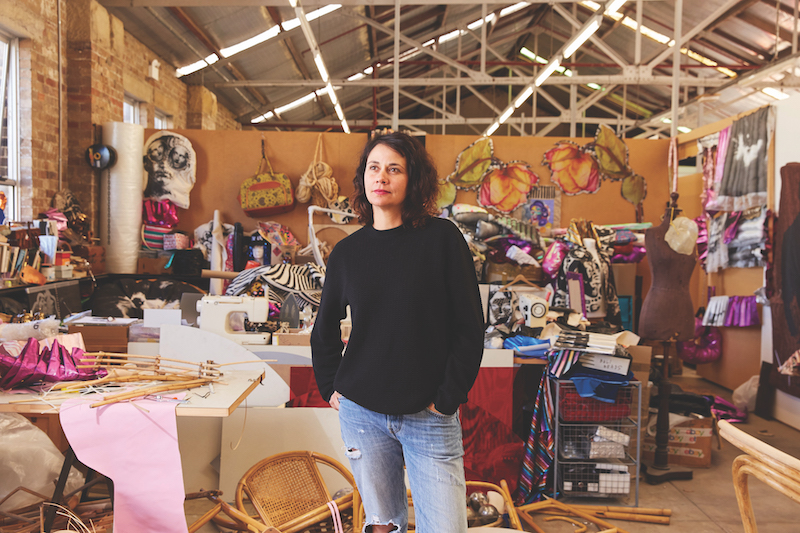Sarah Contos: The Spellbinder
Beauty in trauma, magic in dirt… to understand the work of Sarah Contos is to understand how uncomfortably comfortable she is with life’s endless contradictions.
Words: Carrie Miller
Photography: Nick De Lorenzo
Picasso famously said that “art washes away from the soul the dust of everyday life”. If this is true, then Sarah Contos’ approach to her practice can be understood as a wilful act of resistance against the great man of 20th-century art. She takes the messy reality of daily existence – that banal particulate matter so often dismissed, derided and discarded – and elevates it to the status of art object.
Contos has always mined popular culture for artistic inspiration. Her influences are diverse and perverse: soap operas; old Hollywood; monster movies; rattan furniture. The artist’s latest work digs even deeper into the psychological minefield of the everyday. While still concerned with mass cultural artefacts as “comfort objects” – consolations for unfulfilled suburban dreams – Contos says she has turned her attention to the “human trace that’s been left behind in these objects”. She breaks apart preloved things – jackets, furniture, bedding items – and reconfigures them as “absurd versions of their life”, she says, “new incarnations that reflect and attempt to understand the big existentialist questions”. She finds a sad beauty in those human traces that leave a residual mark on objects whose owners are probably long gone. The smell, pocket detritus, where they have been worn out the most.
Born and raised in Perth, Contos relocated to Sydney in 2009. She had been a costume designer for the theatre as well as a visual artist in her home town, but committed to a full-time art practice once in Sydney. Contos’ work was exhibited in Future Primitive at Melbourne’s Heide Museum of Modern Art in 2013, where it caught the eye of eminent gallerist Roslyn Oxley. Oxley curated the artist into a group show in collaboration with former Melbourne space Utopian Slumps at her Sydney gallery the following year, officially representing her shortly after.
Contos rapidly gained critical notice, reflected in an impressive array of institutional shows and awards. She was a finalist in the John Fries Memorial Prize and the Redlands Art Prize in 2017. In that same year she won the inaugural $100,000 Ramsay Art Prize – now considered one of Australia’s most prestigious contemporary art awards. Her practice has also benefited from the unique professional development opportunities provided by residencies; most recently the Cité International des Arts, Paris, awarded by the Art Gallery of New South Wales.
But one of the highest points of her career so far involved transforming the foyer of the National Gallery of Australia with a spell-binding, immersive installation – one of Balnaves Contemporary Intervention Series. The ambitious scale of Nikola Tesla sends Theda Bara to Mars (2018), allowed viewers to get a feel for the artist’s deeply intimate relationship with the materials she works with. The materiality of Contos’ practice – those tactile, soft sculptural assemblages hand-sewn by the artist – is not a means to an end, but what gives it its conceptual force.
Through her practice Contos seeks to understand how materials – the stuff from craft stores and thrift shops – have, as she puts it, “agency through multiple histories, geographies and societal constructs”. Her work reveals the infinite networks of association – the multiplicity of connections – that constitute our shifting relationships to mass culture: the way dominant cultural narratives are fictions that serve particular sociopolitical purposes and, as fictional narratives, can be reauthored.
This preoccupation with materiality commits her to a very process-driven practice and means that the studio is an important space for her both physically and practically. “I understand concepts and emotions better when I’m being physical and therefore need the space to play and experiment,” she says. Contos reveals a need to be “able to create several things simultaneously, so that when materialised [they] can come together to create relationships or dialogues I wouldn’t be able to conceive by white paper planning.”
Daniel Mudie Cunningham, curator and director of programs at Sydney’s Carriageworks, is a huge fan of Contos and a champion of her work. Contos is a current artist in residence at the Clothing Store at Carriageworks, giving Cunningham a front-row seat to the artist’s practice. He says that her studio “is a sight to behold. Imagine a happy-sad catastrophe of colour and movement; an inviting lair where tactile sculptural forms appear embalmed in recycled teenage tears.”
To understand Contos and her work is to get how uncomfortably comfortable she is with contradiction. Her work holds in dynamic tension “innocence and perversity”, “excess and thrift”, as Cunningham has noted. She finds beauty in trauma, magic in dirt, art in popular culture. These paradoxes extend to her life. “I make quilts for art but never for warmth. I watch cooking shows but never cook. I want to cover my home in florals, but it ends up in wine stained sequins. By using these materials, it’s an acceptance of the person I am and the life I have decided to live.” No-one can contradict that.
This article was published in Art Collector issue 90, Oct-Dec 2019.











